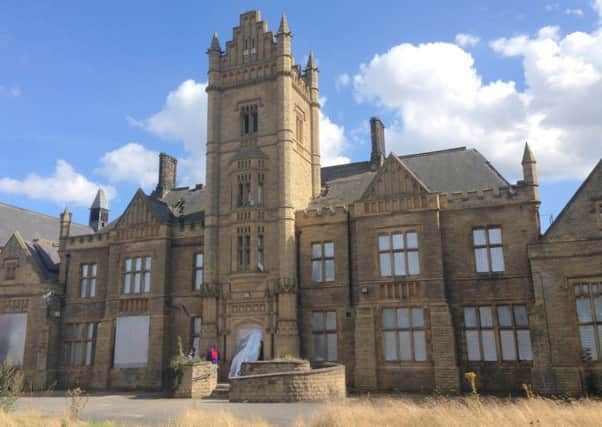Landmark buildings in Yorkshire and the North are on new danger list


The Victorian Society has released its 2016 top 10 endangered buildings list, which for the first time has no properties in London and the South-East after relatively few nominations from those areas.
Buildings in the top 10 include a mill in Grimsby which was part-converted to flats but has structural problems, a railway station in Cardiff thought to have been designed by Isambard Kingdom Brunel and a church in Cheshire with wall paintings and stained glass windows.
Advertisement
Hide AdAdvertisement
Hide AdAlso on this year’s list is a Devon brick factory where Grade II listed buildings are under threat and the derelict Philip Webb arts and crafts house where Bell, a pioneer explorer of the Middle East, once lived.
The charity’s director, Christopher Costello, suggested the contrast in fortunes of old buildings in different areas reflected the “vastly different financial climate” for development in many places outside the South-East.
But he and the society’s vice-president, TV presenter and comedian Griff Rhys Jones, urged local people to seize the opportunity to save the buildings.
Publicity from inclusion on the endangered list often sparked new interest in the buildings which could help protect them, the charity said.
Advertisement
Hide AdAdvertisement
Hide AdMr Costelloe said: “This year, for the first time, the top 10 has no entries from London or the South-East. We simply got far more nominations from other regions.
“This perhaps reflects the vastly different financial climate for development in many areas outside the South-East.
“Retaining historic buildings like those in the top 10 is vital to maintaining local identity and creating places in which people want to invest, live and work.”
Rhys Jones added: ‘The nationally important buildings on the Victorian Society’s top 10 list are in dire need of help. Many of them are in prominent locations in their towns and cities.
Advertisement
Hide AdAdvertisement
Hide Ad“Following my experience with the Hackney Empire I know how difficult finding funding can be - especially outside London.
“However, restoring important historic buildings is worth investing in as it can be a catalyst for wider regeneration.
“I hope people living near these buildings will seize this opportunity and campaign to save them. Ultimately, it is the support of local people which will ensure that they are not lost forever.’
The full top 10, in no particular order, is:
:: Red Barns, Redcar, North Yorkshire, a Grade II* listed building by arts and crafts architect Philip Webb, former home of Gertrude Bell, which is in a “terrible state” with internal water damage, while plans to convert it to flats have not commenced.
Advertisement
Hide AdAdvertisement
Hide AdThe Victorian Society suggested the developer could support the local campaign to turn it into a museum to Bell.
:: Victoria Mill, Grimsby, Lincolnshire, a Grade II former flour mill, warehouse and office complex which was partially converted to flats in the 1990s.
The tower, which was not converted, suffered structural problems leading some people being moved out temporarily as their homes were declared unsafe, and the council was forced to carry out work to help them return and prevent a collapse on a main road.
:: Old Bute Road Railway Station, Cardiff, a Grade II* station which was thought to be designed by Brunel and was home to the first steam-powered train service in Wales.
Advertisement
Hide AdAdvertisement
Hide AdIt has fallen into dereliction after a museum it housed closed and a modern shelter has been built at the station.
:: Old Library, Stafford, Staffordshire, a Grade II building partially funded by philanthropist Andrew Carnegie and once housed Clement Lindley Wragge’s collection of ethnographic, zoological and geological material.
It was sold in 2012 and appears to be on the market again, with its future uncertain. The Victorian Society urged the council to compulsorily purchase it and give it to a community group which wants to create an arts and cultural hub there.
:: Mount Street Hospital, Preston, Lancashire, a Grade II high Victorian Gothic building, which was built as an orphanage and was later a convalescent home but has been empty for more than a decade.
Advertisement
Hide AdAdvertisement
Hide AdUrgent action is needed to implement plans to convert it into residential properties before the building is lost, the society warns.
:: Clayton Hospital, Wakefield, West Yorkshire, is not listed but is a very high quality carved stone Tudor revival building which dominates the surrounding conservation area.
It is threatened under a planning application by the foundation which owns schools on either side of it to demolish the hospital to enable expansion, the Victorian Society said.
:: St Paul’s Church, Boughton, Chester, Cheshire, a Grade II* church with a “stunning interior” which retains wall paintings and stained glass windows by leading artists.
Advertisement
Hide AdAdvertisement
Hide AdThe church is going through a closure process after the congregation merged with another church, and the Victorian Society warned the building was too important to be left to deteriorate with no plans for its future.
:: St Joseph’s Seminary, Upholland, Lancashire, a Grade II complex of Gothic sandstone buildings which was first a seminary and then a boarding school whose alumni are said to include comedians Tom O’Connor and Johnny Vegas.
The buildings closed in the early 1990s and have been decaying since, but could be converted to residential properties.
:: Rylands Mill, Wigan, Greater Manchester, A Grade II listed former cotton mill, with boiler, engine house, chimney and weaving sheds which has lain derelict since the early 2000s, posing a risk to children who trespass, and is currently for sale at £2.5 million.
Advertisement
Hide AdAdvertisement
Hide Ad:: Oliver Buildings, Barnstaple, Devon, the Grade II Shapland and Petter brick factory, showroom and office complex on the riverside in the town, designed by William Clement Oliver.
The Victorian Society said the developer who owned the site tried to get the recent listing overturned, and urged the company to produce plans incorporating the buildings “without any further delay”.